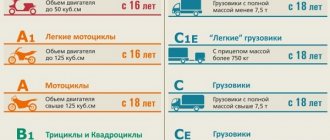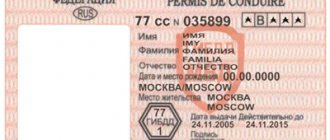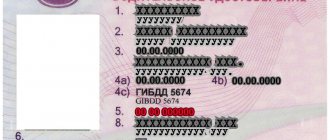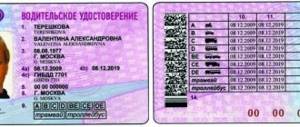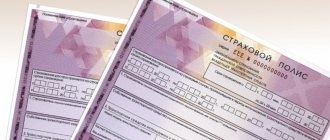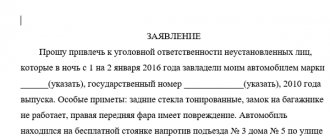There are two types of rights: national ID and international. The main difference between them lies in the name itself - some allow you to move freely throughout the territory of the Russian Federation, others - in all countries of the world. International or national driver's license - what to choose for traveling abroad, in Russia and the CIS countries?
It is very important to remember that the procedures for obtaining, the cost, and the arrangement of points for the two types of this document are different. Moreover, there are differences in the obtaining procedure. All drivers who have a national license but want to travel abroad should know what an international standard license looks like and what procedures must be followed to obtain it.
National ID and regular driving license
A few words about national rights. Firstly, they operate exclusively on the territory of our country. Secondly, there are never any difficulties in obtaining them, because they are issued in almost all traffic police departments of all more or less large cities. Sometimes the interaction between a citizen and an authority is complicated by the fact that the rights were seized in one city, and he declares their return in another.
Standard licenses include the following information about the driver:
- last name, first name and patronymic;
- serial number and series;
- photo;
- place, date of birth and address;
- acceptable transport categories;
- date of issue.
All specified data is in Russian in two forms: Cyrillic characters and Latin letters (transliteration).
A standard license is awarded only after he passes all the necessary exams and pays the state fee. The fee is 500 rubles if the driver wants a license in paper form and 2000 rubles if in plastic.
National document
The concept “national” in this case means belonging to territorial use. A national document is valid only on the territory of our country. To travel abroad by car, the car owner must prove his ability to drive a vehicle and knowledge of the rules. To do this, it is not necessary to go to a driving school again; it is enough to obtain documentary evidence, which will be taken into account by traffic police officers in other countries.
If traveling outside the Russian Federation while driving a car is not important for you, then you can freely move around the territory of the Russian Federation with a generally accepted Russian driver’s license.
Features of the visual appearance of the national driver's license
The main purpose of this document is to serve as proof that the owner of the document has the legal right to drive transport on the territory of the Russian Federation.
If we are talking about international rights, then this document has a slightly different meaning and method of application. If in the Russian Federation it is allowed to drive with only one license - a national one, resembling a bank card in shape, then abroad, in addition to the usual license, you must present an international one.
International and national rights cannot be mutually exclusive! Driving around Russia with an international license is prohibited if the driver does not have a regular, national one. The standard document is more significant; it is the one that certifies the right to drive transport.
Therefore, the driver does not have a choice: which driver’s license is better, national or international, since one is impossible without the other.
There are three documents that fully describe the required format of rights in Russia and regulate their application:
- Government Decree No. 1097 of June 24, 2014.
- Traffic rules
- Orders of various institutions, in particular the Ministry of Internal Affairs.
To understand what a national driver's license looks like, what an international ID card looks like, and why this is so, you should turn to an older type of document. The visual appearance implies approximately the same standards as the standard document allowing drivers to move on the roads 20-30 years ago. There are, of course, some changes and additions, but the main essence remains the same. The changes affected the color of the ID, the location of security signs, points, etc.
To date, the country has approved a new generation of national IDs, which are approved internationally by the Vienna Convention.
The national driver's license has the following features:
- the document is a hard plastic product;
- on the left side of the card there is a red oval-shaped “RUS” emblem, symbolizing the state in which these rights are an identification document;
- a list of items that discloses information about the owner of the document;
- on the back there is a barcode and a table with categories allowed for driving, their opening and closing dates;
- ID series and number;
- abbreviations and notes (located below the category table);
- signature and photograph.
The rights also contain information printed in Latin letters. In international law everything is very similar, however, there is also a translation into French.
What is a Russian driver's license
According to the traffic rules, every motorist must have with him a document confirming his driving rights. According to Russian law, it is called a driver's license. It is issued for driving vehicles within the country.
This does not mean that you cannot travel abroad with them. They simply operate unconditionally on Russian territory. The possibility of their use in other countries depends on the international laws and regulations of the specific country of entry.
Russian or national driving licenses are issued to citizens subject to certain conditions. The future driver must reach the age at which he is allowed to drive the appropriate vehicle. This rule is established by the Law “On Road Traffic Safety” No. 196-FZ. In addition, to obtain a certificate you need to undergo a special medical examination and pass an exam.
Russian drivers can also obtain international driving licenses. They are issued on the basis of national rights. The procedure for obtaining them has certain features. Let's look at how an international driver's license differs from a regular one.
What is an international driving license?
International law (IDL) is a document that performs different functions, looks different and requires different procedures. The goal is to meet the international standard. Let's take a closer look.
The difference between the two certificates lies, first of all, in convenience - traffic inspectors abroad are trained to recognize special types of documents.
The outer side contains:
- Name of authority and date of issue.
- Validity.
- Number and series.
- A state in which the owner of the rights is a citizen.
The reverse side contains a list of states in whose territory the document will have legal force.
International rights are an addition, a license that expands the capabilities of the main document. The IDP does not even contain the driver’s name, and is linked to national ones only by the series and number of the document.
Not all countries require exactly the international standard of rights from Russian citizens. There are countries (mainly the CIS) where the usual standard is suitable. For example, the legislation of Armenia and Georgia allows you to travel within the state using regular IDs. Very often, in some countries, employees require an IDP. This may mean that the employee is either poorly versed in the law or is demanding a bribe.
When receiving an IDP, you must pay a state fee of 1,600 rubles. The dimensions of international rights are slightly larger than those of standard ones.
IDPs are printed in two languages: Russian and French. The document contains special oval-shaped seals. Photos of the international ID are also larger in size and are marked with special stamps.
The appearance of this document provides the following features:
- rights are issued in the form of a book, not a card;
- at the top of the document the name of the state in which the certificate was issued is marked in golden colors;
- four sheets inside the brochure have a translation from French and transliteration of Russian words;
- the “RUS” emblem is indicated under the golden name of the state;
- the name of the certificate, series and number are indicated in the center;
- Near the marks with the names of acceptable categories there is a matte photograph of the driver.
International rights are printed in two languages: Russian and French. The document contains special oval-shaped seals. This way the categories of vehicles that the driver has the right to drive are marked. Photos of the international ID are also larger in size, and here they are marked with special stamps.
What is the difference between national certificates and international certificates?
The procedure for issuing licenses to motorists is outlined in Government Decree No. 1097 dated October 24, 2014, entitled “On permission to drive vehicles.”
From this document you can learn how international laws differ from national ones. They differ in type, the order of their provision, timing and scope of validity.
National licenses are issued primarily for use in Russia. Today they exist in two types: old and new.
Since the certificate is valid for ten years, licenses issued before 2011 that have not expired do not need to be changed. When preparing new rights, international rules are taken into account.
An international document (IDP) is used for presentation abroad. It is derived from the Russian identity card and is not used separately from it. If a driver does not have a national license, then he cannot drive a vehicle in Russia, nor can he obtain a foreign license.
Russian and international IDs look different. A modern local car license is a small plastic card filled out on both sides. The foreign sample is larger in size and looks like a book. It is filled out in several languages and contains the following information:
- document number and series;
- date of issue and validity period;
- issuing authority;
- Russian license number;
- information about the driver;
- category of funds that can be controlled.
This booklet must be affixed with the seal of the authority and the signature of the person who issued it. A photo of the car enthusiast on a white background is pasted into the document. Almost all inscriptions are made in Latin, which makes it easy to read their data abroad.
The local document also contains information about the car owner, the date and place of its issue, driver category, and serial number.
This laminated card also includes the driver's signature and a photo of the motorist. In addition, licenses after 2011 are equipped with a barcode, which allows police officers to obtain all information about their owner.
National and international driving licenses: important differences
As we have seen, the differences between the two different types of driver's licenses are quite significant.
Let us note seven criteria by which differences between documents should be assessed:
- Typical differences.
- Passing a medical commission.
- A set of necessary documents.
- Receipt procedure.
- Education.
- Amount of penalties for violations.
- Price.
Let's take a closer look at each of the criteria.
We will present typical differences between certificates in the form of a special table:
| Type of difference | National rights of Russia | International rights |
| Functionality and objectives of the document | Allows you to manage transport on the territory of the Russian Federation | Allows you to drive vehicles outside the Russian Federation |
| Appearance | Two types: · plastic (card 5.4x6.6 cm); · book (2 sheets of A6 format). | The book is made on thick paper, format – A6. |
| Chroma | White with pink tints, watermarks present. | The cover is gray, the inner block is white. |
| Protection level | · holograms; · special deep color gradients; · “State Traffic Police” stamp and system code protected by law; · barcode. | Availability of seals in round and oval shapes. |
| Filling with data | Computer printing | Computer printing or manual entry. |
| Validity | 10 years | 3 years |
| State duty upon registration | · plastic card – 2000 rubles; · paper format – 500 rubles. | 1600 rubles. |
| Availability of insurance | Through a special policy. | Through a special foreign policy. |
Thanks to new changes in legislation, from 1.01.18 to 1.01.19 it is possible to receive a 30% discount on registration of state fees. To do this, you should apply for a driver’s license through the State Services website.
The discount applies to registration of both national and international rights.
Types of rights
In 2021, several types of national driver's licenses can be found on the territory of the Russian Federation.
This is due to the fact that some time ago a decision was made to change the appearance of the rights. But all car owners did not have to immediately go and exchange their old licenses for new ones. There is no need to exchange anything until the expiration date of the previous sample.
After 10 years have passed since you received your old driver's license, you will need to exchange it.
Then the car enthusiast will receive a new model.
"Old"
Driver's licenses produced before 2009 are printed on paper and covered with a special film on top. All data of an individual is written only in Russian, except for the last name, which is duplicated by transliteration in Latin.
The features are:
- Old driving licenses do not have a barcode. Therefore, it is impossible to carry out electronic identification using the “old” model.
- The “special labels” column does not contain any information.
- The number of categories is only 9 positions.
Gradually, drivers begin to receive new driver's licenses, displacing the old model.
"New"
in 2014, updated models of driver's licenses began to be officially issued on the territory of the Russian Federation. However, in fact, back in 2011, one could see a new format in the country. The very first and most important difference is their physical medium. Now motorists present a plastic card containing information in the following form:
- surname, first name, patronymic in Russian, which are duplicated in Latin;
- all other information on the front side of the rights is also written in English;
- compared to the old rights, the number of categories has been increased to 16;
- there is a barcode with which you can instantly identify rights in the electronic database;
- the photo is not pasted in, but applied in a special way, photographing is carried out directly at the place where the document is issued;
- there is a signature of the owner;
- the form number must be entered;
- the region of residence of the individual is registered.
Plastic licenses have a different color scheme, which smoothly transitions from light blue to a light pink tint. Their size remained unchanged compared to the previous ones.
In addition, the driver’s license is marked RUS. This means that with such a document, the owner of a vehicle can move freely throughout the entire territory of the Russian Federation.
For maximum protection of “rights,” images are used that are hidden from human eyes and appear under a special device.
In addition, there is microtext on the plastic to enhance protection.
International sample
To legally drive a car in foreign countries, you must obtain an international driver's license. Its main feature is that their validity period cannot exceed the maximum period of validity of internal “rights”. However, a candidate for their receipt can apply for an international sample for 1, 3 or 5 years.
It is worth remembering that when traveling abroad by car or renting one abroad, you need to take both documents with you:
- national driving license;
- foreign sample.
International driving licenses do not require retaking the driving theory and practice exam. In addition, the conclusion of a medical commission is also not needed.
Temporary
There is another type of driver's license - temporary. It is issued to an individual in strictly defined situations:
- When permanent rights are in the process of being exchanged. In this case, you must present a registration certificate on a certain form to the State Traffic Inspectorate and confirm that the state fee has been paid. Only after this can you receive a temporary document.
- The permanent license was confiscated from the car owner for violating the law. Temporary is thus issued free of charge.
At its core, this document gives the same rights to a person as a permanent one. There is only one limitation: you cannot travel abroad with it by car.
Important! As soon as a permanent sample is issued, the temporary license must be handed over. Otherwise, the person may be subject to penalties.
Passing a medical examination
There are many situations in which a driver should change his license: its validity period has expired, a replacement or exchange for a newer one is required, the license was returned after an arrest, etc. (there are many reasons why a driver’s license can be revoked and all of them are prescribed by Russian legislation and the theory of the state and TGP rights). Each time the driver needs to follow one procedure - undergo a medical examination.
In this matter there are also significant differences between the two types of documents. When receiving, restoring or returning a RF TDP, the need to submit a medical form is mandatory. When receiving an addition to your license in the form of an IDP, a certificate is not required.
When receiving a standard type document, a medical certificate must be provided if we are talking about changing the driver’s personal data, for example, first or last name.
This procedure is also mandatory if:
- the driver opens another category;
- there is a loss of identification;
- the driver needs a duplicate.
The IDP, being rather an addition to an existing document, is created on the basis of data already noted in national rights.
Thus, the very presence of an IDP implies passing a medical commission. If a driver wishes to open another driving category, but his medical certificate is still valid, he should not obtain a new one. All medical certificates are valid for 1 year. They can be extended by passing a second commission.
Price
The costs of obtaining a driver's license consist of the following:
- Payment for driving school, the amount of which is about 20 thousand rubles. However, the price may depend on various factors, for example, the number of hours of training driving.
- Photos for autocourses in 3 cm by 4 cm format under the right and left corners - about 200 rubles.
- Passing a medical commission also requires a fee (approximately 1500-2000 rubles). Each healthcare institution may set its own prices. It is important that the clinic has a license to provide certificates to car owners.
- Purchase of additional literature for training.
- Preparation of photocopies of documents.
- Theoretical exam – 60 rubles.
- Practical driving – 100 rubles.
Additional costs may be associated with re-testing at the traffic police, car rental, etc.
Set of necessary documents
To obtain a DDP and an IDP, sets of documentation are required, which differ from each other.
For standard rights you need:
- Citizen's passport and birth certificate.
- Previous DDPs, if any.
- Medical certificate, if you have one and it has not expired.
- Certificate of passing examinations (if required).
- Photo.
In order to receive the long-awaited certificate, you need to prepare a set of relevant documents. After the traffic police officer has checked all the documents, he checks the relationship between their contents and the driver’s statement. After this, if everything is normal, the process of creating a document and entering information into the database begins. A process that in one way or another precedes the receipt of a document.
The IDP provides for:
- NVU.
- Citizen's passport.
- International passport.
- Photo.
As for obtaining a visa, in the case of a standard ID, it is required, but not with an international one.
Documents for initial receipt
Now let’s find out what papers may be useful for completing the relevant documentation. Let's start with the initial acquisition of national rights.
The future driver will have to prepare:
- statement;
- certificate of completion of training;
- form v/u-003;
- photos;
- receipt for payment of state duty;
- military ID (if available);
- identification.
In reality, everything is simpler than it seems. What about the exchange of national rights?
Receipt procedure
The procedure for obtaining both types of rights is quite similar, but there are differences.
A striking example is fines: if fines are not paid, then there is no chance of getting new rights, regardless of their type. There are differences in the procedure for obtaining them, primarily in matters of relationship with visas.
For example, to obtain an international document you need:
- visa application;
- foreign passport;
- certificate of good conduct (not always);
- other documentary details required for traveling to another state.
Standard licenses do not require this, because they allow you to move around the Russian Federation. However, the exception, of course, is when the driver plans to visit countries that are present in the Geneva Convention.
Passing exams is a time-consuming procedure that is sometimes very tedious for drivers; it is not required at all to obtain an IDP.
National licenses take about 30 days to produce, and international licenses in less than one hour.
Learning differences
Training is the basis of driving, an integral process through which, one way or another, all drivers who either obtain a license for the first time or open a new category must go through.
When it comes to training, the difference is also great. When obtaining a standard license, a driving school is of great importance and is a necessary requirement if:
- This is the first time a certificate has been issued.
- A new category is opening.
- The arrest has come to an end.
In the case of an IDP, training is not required, nor is passing the relevant exams. The document will be issued on the basis of fundamental rights.
Punishment for violation
All types of punishments, in particular for traffic violations, are always clearly established in accordance with the legislation of the country in which the law was violated.
It could be:
- non-compliance with the rules on the road;
- ignorance of blood alcohol standards (each country has its own standard);
- ignorance of the reasons for arrest (in the USA, for example, the reason for arrest is often something that in Russia is punishable by a fine).
Drivers should remember that before visiting other countries, it is very important to understand foreign traffic rules, since the degree of punishment for their violations in another state is very different from Russian ones. Most problems on the road occur precisely because of ignorance of the laws.
The position of the steering wheel is also important. You should be especially careful in countries with right-hand drive traffic, for example, in Britain or Japan. Statistics show that most of the violating tourists and migrants come from “left-hand drive” countries. Good legal knowledge can mean a lot even for tourists who are in the country for just a few days.
There are many examples of problems due to ignorance of the laws of other countries, starting with a man who did not turn on his turn signal when approaching a car and paid more than 500 euros in fine and a woman who was arrested because her child was not wearing a seat belt and was not in child car seat.
